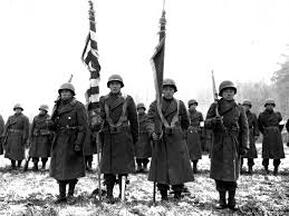|
Would you put your life on the line for a nation that has unconstitutionally imprisoned you and your family, most of you citizens, in a concentration camp?  Yet thousands of young Japanese men and women did just that during World War II, enlisting in the American military even while they and their families were held in Japanese-American relocation camps as “enemy aliens.” Many of whom became the most decorated U.S. soldiers in the war. Early into the internment camps, the administration of President Roosevelt debated whether to allow Nisei—children of Japanese immigrants born and educated in America—to serve in the U.S. military. FDR announced in February 1943 that they could serve. On March 23, 1943, the military organized the 442nd Regimental Combat Team. It drew its troops from volunteers and draftees from Nisei inside the concentration camps. This did not go over well among many camp internees, outraged at the notion of serving the very country imprisoning them. They petitioned the government to at the least not assign them to segregated units, but their petition failed. (Doesn’t this remind you of the northern all-black units of the Civil War?) Consequently, a mere six percent of military-aged Japanese males initially volunteered. Ten percent volunteered from Camp Amache, the highest percentage of all the camps. Among them was the man I mentioned in an earlier blog who drew a running cartoon for the camp’s newspaper about a little Nisei boy living in the camp. Ultimately, over 30,000 Nisei from across the country served in World War II, including women. The 442nd trained at Camp Shelby, Mississippi, where the Nisei witnessed firsthand the segregation and anti-black racism of the Deep South. Some intervened to the point their officers had to reprimand them and point out that they were not about to end Jim Crow. The 442nd shipped to Europe, attached to the 5th Army under the command of General Mark Clark. There they were augmented by the 100th Battalion, formed from a National Guard unit in Hawaii. The unit was composed almost entirely of Nisei (under white officers) who had joined the military prior to the attack on Pearl Harbor, and had already experienced brutal combat in Italy. The combined units fought with uncommon distinction in seven campaigns in Italy and France. It was credited with rescuing the “Lost Battalion” surrounded by Germans in the Argonne forests of France. Ironically, the 442nd’s field artillery battalion, detached to the army in Bavaria, also liberated a Nazi concentration camp and stopped a death march. The 442nd, and its attached 100th Battalion unit, were awarded over 18,000 individual decorations, including 21 Congressional Medals of Honor, earning the nickname “Christmas Tree Regiment.” Several French towns liberated by the 442nd continue to honor the regiment with monuments, museums, and street names. And interestingly, members of the U.S. Congress supporting the effort to bestow Hawaii statehood in the 1950s cited the heroic actions of the 442nd rescuing the Lost Battalion. When President Truman awarded a Presidential Unit Banner in 1946 to the 442nd, whose motto was “Go For Broke,” he said, “You fought not only the enemy but prejudice—and you won.” The decorations and honors came at great sacrifice. The unit suffered more casualties per man than any unit in American history. Of the nearly 1,000 internees from Camp Amache who served, 31 died (a plot element in my mystery The Big Dive). Why such bravery and heroism for a nation whose citizens often despised and distrusted its Japanese countrymen? Said one Nisei quoted in a book on the Manzanar relocation camp: “We were fighting for the rights of all Japanese Americans. We set out to break every record in the army. If we failed, it would reflect discredit on all Japanese Americans. We could not let that happen.”
2 Comments
|
Bruce Most is an award-winning mystery novelist and short-story writer. His latest novel, The Big Dive, is the sequel to the award-winning Murder on the Tracks, which features a street cop seeking redemption while investigating a string of murders in 1949 Denver. His award-winning Rope Burn involves cattle rustling and murder in contemporary Wyoming ranch country. Bonded for Murder and Missing Bonds features feisty Denver bail bondswoman, Ruby Dark. Archives
February 2022
Categories |

 RSS Feed
RSS Feed